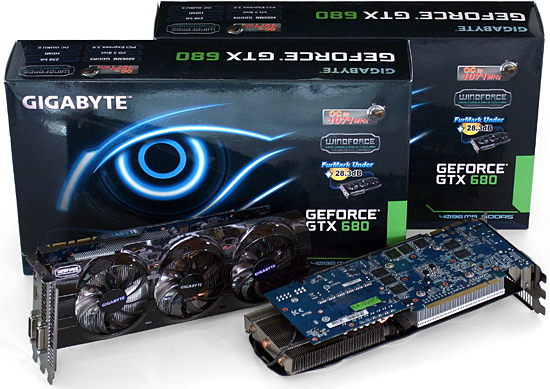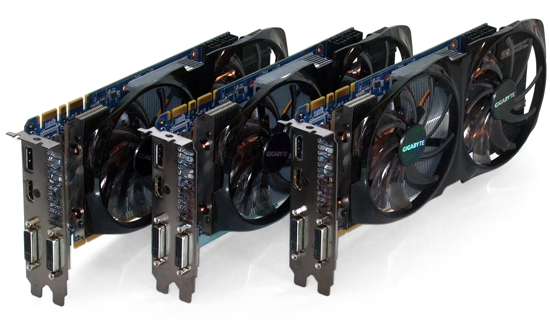Do Two GeForce GTX 680s Beat Three GeForce GTX 660 Tis In SLI?
Two GeForce GTX 680s or Three GeForce GTX 660 Tis?
When we reviewed Nvidia's GeForce GTX 680, it was the most powerful GK104-based card in the company's line-up (GeForce GTX 680 2 GB Review: Kepler Sends Tahiti On Vacation). Not long after, it was eclipsed by the GeForce GTX 690, though, employing a pair of the same GK104 GPUs running at slightly lower frequencies on a single board (GeForce GTX 690 Review: Testing Nvidia's Sexiest Graphics Card).
The GeForce GTX 690 is a bit quieter than two GeForce GTX 680s in SLI. When it launched, it was also about the same price, though the 680s now cost a little less. They're also faster than the dual-slot 690. So it'd seem that, for $920 bucks or so, two GeForce GTX 680s are about as fast as you can get for under $1,000.
Can anything from Nvidia outpace two 680s for less money? A trio of GeForce GTX 670s would easily get the upper hand, but they'd also push our budget back above $1,100.
The GeForce GTX 670 isn't Nvidia's least-expensive high-performance card, though. The same GK104 graphics processor found in the 690, 680, and 670 can also be found in the company's GeForce GTX 660 Ti (GeForce GTX 660 Ti Review: Nvidia's Trickle-Down Keplernomics). And that board sells for about $290, ducking in under $900 when you buy a trio. Seems like a pretty good match up against those two GeForce GTX 680s, right?
| Gigabyte Vs. Reference GeForce Specs | ||||
|---|---|---|---|---|
| Row 0 - Cell 0 | Gigabyte N680OC-4GD | Nvidia GTX 680 2 GB | Gigabyte N66TOC-2GD | Nvidia GTX 660 Ti |
| Shaders | 1536 | 1536 | 1344 | 1344 |
| Texture Units | 128 | 128 | 112 | 112 |
| Full Color ROPs | 32 | 32 | 24 | 24 |
| Graphics Clock MHz (Boost) | 1071 (1137) | 1006 (1058) | 1032 (1111) | 915 (980) |
| Texture Fillrate | 137.1 Gtex/s | 128.8 Gtex/s | 115.6 Gtex/s | 102.5 Gtex/s |
| Memory Clock | 1502 MHz | 1502 MHz | 1502 MHz | 1502 MHz |
| Memory Bus | 256-bit | 256-bit | 192-bit | 192-bit |
| Memory Bandwidth | 192.3 GB/s | 192.3 GB/s | 144.2 GB/s | 144.2 GB/s |
| Graphics RAM | 4 GB GDDR5 | 2 GB GDDR5 | 2 GB GDDR5 | 2 GB GDDR5 |
| Die Size | 294 mm² | 294 mm² | 294 mm² | 294 mm² |
| Transistors (Billion) | 3.54 | 3.54 | 3.54 | 3.54 |
| Process Technology | 28 nm | 28 nm | 28 nm | 28 nm |
| Power Connectors | 2 x 6-pin | 2 x 6-pin | 2 x 6-pin | 2 x 6-pin |
| Maximum Power | Not Specified | 190 W | Not Specified | 150 W |
| Price | $540 | $460 | $300 | $290 |
Gigabyte sent over two sets of cards to help answer our question, along with a bit of a surprise: its GeForce GTX 680s were 4 GB versions of the WindForce 3x-based overclocked board. Although N680OC-4GDs represent the best of the best from Gigabyte, they also skew the performance and pricing of our comparison upwards.
A trio of its overclocked GeForce GTX 660 Ti graphics cards would have helped balance the scale, but the trio of N66TWF2-2GDs we received weren't aggressively-tuned enough. We applied the firmware corresponding to Gigabyte's N66TOC-2GD to make this a fairer fight.
More memory and higher frequencies made the GeForce GTX 680s great for comparison purposes, but not as ideal for setting a baseline performance level. Because we also tested the N680OC-4GD in single-card mode, adding one reference GeForce GTX 680 2 GB helped set a standard we could use to determine how much extra speed the specially-tuned cards add.
Get Tom's Hardware's best news and in-depth reviews, straight to your inbox.
Current page: Two GeForce GTX 680s or Three GeForce GTX 660 Tis?
Next Page Test Settings And Benchmarks-
renz496 off topic:Reply
when titan's review comes out?
on topic:
frankly i'm no multi gpu nor multi monitor user. but for the green camp if you want multi monitor gtx 660 ti 3Gb is a good choice if you want the cheap option. if you want more horse power while still on the cheap side then 7950 is the answer. (the latest game bundle from amd might also lean some people to buy amd cards)
-
A sneak peak to the GTX Titain 6GBs. From the website "WCCF Tech"Reply
http://wccftech.com/nvidia-geforce-gtx-titan-pictured-gk110-finally-arrives-consumers-blasting-6-gb-memory/ -
rantoc From my own experience I would rather go with 2x 680 as dual sli scales very well on about _all_ titles while tri/quad sli can be more of a gambling in performance - For titles where all the cards scale well its sure nice as hell - Where it does not you can even loose performance by adding a third/fourth card (even thoo that scenario gets less and less frequent).Reply -
hero1 Nice review, makes me consider taking 3x7950 instead of 2x7970. Would equal in price due to sales that are going on. But, maybe grab a Titan? I hope to see another review in 8 hrs featuring Nvidia GeForce Titan.Reply -
mayankleoboy1 Not the point of this article, but i noticed that a single gtx680 is a complete beast at 1080P.Reply
Also, it would have been interesting to see the CPU usage during the tests.
Edit : A repeat of this article with the HD7000 cards should be performed, specially after the 13.2 driver are released. -
hero1 mayankleoboy1Not the point of this article, but i noticed that a single gtx680 is a complete beast at 1080P.Also, it would have been interesting to see the CPU usage during the tests.Edit : A repeat of this article with the HD7000 cards should be performed, specially after the 13.2 driver are released.Reply
Yes same review for HD 7000 series should be given. Can't wait for that.
-
merikafyeah I'd still go for a GTX 690 Hydro Copper. Overclock it and pwn while only taking two slots. SLI configs which take up all your slots seem highly inefficient and unappealing.Reply -
rmpumper Why do you say "higher/lower is better" in some graphs? Which is it - higher or lower?Reply



